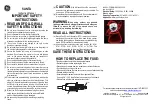
20
N60-6
1.6 Put the top tab “B” of the frame back into the loop on the back of the cheek pad
and refasten the eyelet “A” at the top snap button on the back (Fig.15).
1.7 Refit the complete cheek pad on the helmet (see instructions above).
1.8 Repeat these steps with the padding of the right cheek pad.
2
REMOVING SPACE FOR GLASSES
2.1 Remove the left cheek pad from the helmet (see instructions above).
2.2 Unhook the rear frame eyelet “A” of the cheek pad at the top snap button on its
back (Fig.15).
2.3 Take the top tab “B” of the frame out of the loop on the back of the frame (Fig.15).
2.4 Properly insert part of the previously removed padding into the fabric lining of the
cheek pad (Fig.16).
2.5 Put the top tab “B” of the frame back into the loop on the back of the cheek pad
and refasten the eyelet “A” at the top snap button on the back (Fig.15).
2.6 Refit the complete cheek pad on the helmet (see instructions above).
2.7 Repeat these steps with the padding of the right cheek pad.
WIND PROTECTOR
(Available as standard or accessory/spare part).
This accessory allows improved helmet performance under certain conditions of use.
The Wind Protector reduces unpleasant infiltrations of air under the chin.
1
DISASSEMBLY
To remove the wind protector, pull it outwards with respect to the helmet at the three
fastening tabs (Fig. 17). Then check that the front snap buttons of the side cheek pads
are still correctly hooked.
2
ASSEMBLY
To fit the wind protector, slightly pull the front of the left cheek pad inwards with respect
to the helmet. Then insert the left side tab of the wind protector into the corresponding
seat on the lining of the inner chin guard and push it downwards until it is fully hooked.
Repeat the operation with the central and right tabs too (Fig.17). Then check that the
front snap buttons of the side cheek pads are still correctly hooked.
VENTILATION SYSTEM
The ventilation system of the helmet consists of:
Lower ventilation
It allows ventilation around the mouth and channels the air directly on the visor to
reduce fogging.
See Fig.18 for opening and closing operations.
Top ventilation
It allows diffuse ventilation to the top of the head, even at low speed.
See Fig.19 for opening and closing operations.
INSTRUCTIONS FOR USE
Summary of Contents for N60-6
Page 82: ...82 N60 6 1 1 1 1 2 1 3 2 2 1 2 2 2 3 3 3 1 3 2...
Page 83: ...83 N60 6 EL A...
Page 88: ...88 N60 6 VPS Nolangroup VPS H E VPS 1 1 2 1 2 9 1 3 10 1 4 2 2 1 A 11 2 2 B C 11 2 3 12 2 4...
Page 91: ...91 N60 6 2 5 B 15 2 6 2 7 WIND PROTECTOR Wind Protector 1 17 2 17 18 19 20...
Page 92: ...92 N60 6 FIG ABB EIK KUVA 6B 6A 5 4 3 1 2 A A B B MIN MAX...
Page 93: ...93 N60 6 FIG ABB EIK KUVA 10 14 13 8 12 11 9 7 A A A A B B C C A A...
Page 94: ...94 N60 6 FIG ABB EIK KUVA 18 16 20 19 17 15 B B A A...
Page 95: ......
















































